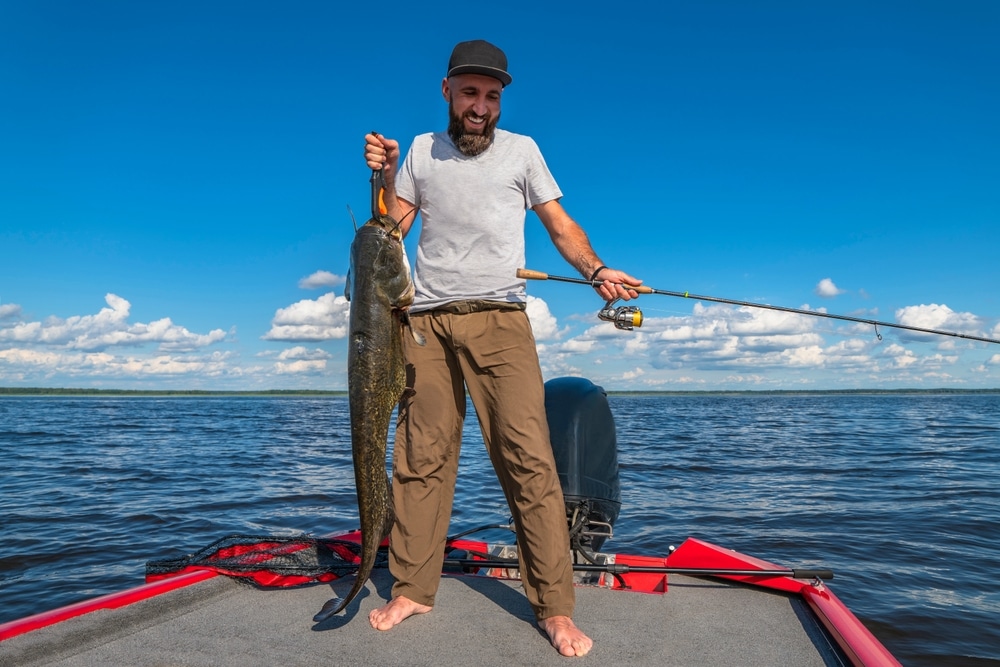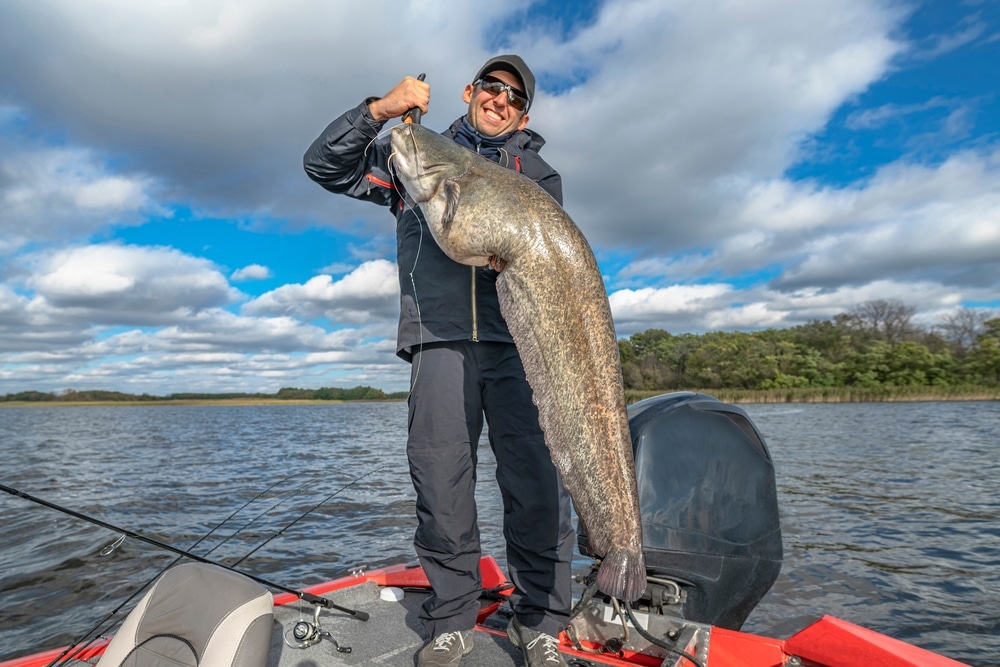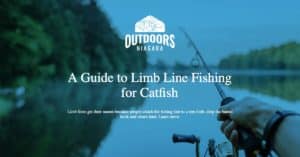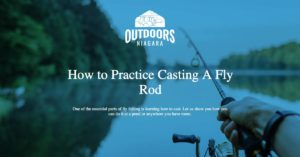Drifting rig setups can be confusing because they have a few parts.
You want to start with a sinker slide that connects to your fishing line.
That will be the junction where your leader setup begins.
To the sinker slide, you want to attach the appropriate drift weight.
A drift weight is a long and slender weight that has some movement to it.
You use these over regular sinkers because they will move through the weeds and structures on the bottom of a lake.
Drifting weights are better for not snagging on underwater structures.
At this point, you’ve set up the line to sink and move with the boat.

Now it is time to talk about setting up your leader.
The overall length of the leader will total about 2.5 feet From the sinker slide you will tie off about 15 inches of the line (the start of the leader) and then tie on a ball chain swivel.
What the ball chain swivel does is it gives some life to your bait as the boat drifts.
Down about 6-8 inches you want a float.
A lot of time a chub float or minnow flow will work well and act as something the catfish may see.
Catfish have poor eyesight so buy a float with a rattle in it.
The vibration will help the fish find your hook.
The float also helps to keep the bait and hook up out of the mud and float about six or so inches off the bottom.
That is a prime distance for catching big catfish.
To the rattle float, you tie on a short leader about 6-8 inches with your hook and bait.

The structure looks like this. – Mainline to a drift weight with a sinker slide.
That will create a Y-shape in the line where the weight will sink to the bottom and provide the positioning of your leader.
The leader is a series of sections of various lengths of line that begin with a short segment to a ball chain swivel (other types of swivels are available.)
The next segment is a short piece that ends in a rattle float – usually a chub float or minnow float – the rattle is what is important.
To the float, you tie on a 6-8 inch segment that ends with your hook and baits.
That is your leader and weight for drifting catfish.
Contents
How Do You Fish for Catfish on A Boat?
There are two ways to fish for catfish from a boat.
The first is to moor the boat in the area you want to target catfish and then bottom fish for them in that area.
The second method of fishing for catfish from a boat is called drifting.
Unlike other forms of drift fishing, you do not power the boat.
Instead, you allow the wind to push the boat along the current.
Once you establish the path you want the boat to travel, position the boat so that the side of the boat is facing the wind.
The wind will catch the boat and gently push it along the water.
The movement is slow, which allows you to target catfish which are also slow.
You can use a drift sock to slow down the speed of the boat’s drift, and also to help control the direction that the boat drifts.
Once the boat is set up to drift, you cast out your line and allow it to sink to the bottom.
If you have set up your rigging properly, the bait should float about five or six inches above the bottom of the water.
If you’ve used a drift weight rather than a sinker, the weight and hook will slide along the bottom of the lake or river as the boat drifts.
What Speed Should I Drift for Catfish?
Drifting for catfish requires a very slow drift. The power of the drift is provided by wind.
Generally, you want the boat speed to be less than one mile per hour and preferably in the range of 0.5-0.8 MPH.
If you are drifting faster than that, use a drift sock to slow down the boat and the drift.
The key to targeting catfish by drifting is slow speed.
If you drift too fast you will miss most of the fishing action for catfish, which are slow and lazy feeders.
What Gear and Rod Should I Use for Drifting Catfish?
Rod
Because drifting for catfish is a slow process you do not need a trolling rod.
A basic catfish rod will do just fine. Aim for a rod that is 7-10 feet long, with medium fast or fast action, and medium to medium-heavy power.
The length up to you but over 7 feet is optimal.
You don’t cast out to drift, though you can toss the line ten or so feet off the boat.
Accuracy is not an issue when you cast on a drift boat for catfish.
You want a rod with medium-fast or fast action so that if you hold the rod you can feel the weight working the hook.
The medium-heavy and heavy power means the rod will handle big fish.
Line
Unlike most fishing, you want to be able to see the line in the water.
Big catfish may take the hook and the rod will not bend.
You will notice that the line is moving away from the boat rather than the rod tip bending.
Catfish have poor eyesight, and they are not shy of fishing line or sinkers.
Choose a line color that you can see in the water because as the line moves and changes direction, you will need to see it.
In the case of catfish, the line color is for you, not them.
A high visibility line or hi-vis line is ideal.
Hooks
#10 circle hooks are the standard.
Weight
Slide weights or drift weights are ideal. An 0.8-ounce weight will do the trick usually.
The drift weights are an ideal setup but the no-flip weights can also work well. Weights over an ounce are not ideal.
You want the weight to bounce along the bottom or slide along the bottom rather than bog down in the mud.
Use just enough weight to keep the line on the bottom, but not so much weight that the sinker wants to bury itself.
What Bait Do I Need When Drift Fishing for Catfish?
Catfish are not visual hunters. They can see, but their vision is poor.
You want to use a bait that leaves a scent trail because catfish will track your bait by smell.
Stinky baits are good. Most successful catfish anglers use shad heads.
Cut baits are a good option.
Carp and perch work well, but any type of cut fish is okay.
If you are fishing with a netted ball, consider sweet corn as a filler.
You can make these up yourself DIY style.
Just cut a 2″x2″ square of netting and add a tablespoon or so of sweet corn.
Form it into a ball by gathering the corners together and then tying it off with fly tying twine.
Should One Drift Blind or Use a Fish Finder?
You can drift blind if you want, but using a fish finder will help you be more successful at targeting bigger fish.
Catfish are often stationary during the day.
Once you know where the fish are you can drift over them.
You can also make several, drift-passes.
Fishing blind is a good way to just spend time on the water.
You have a chance of finding big catfish, but you will do better with a fish finder and a slow drive to map out there the fish are lurking.
Drifting vs Fishing on Anchor, What’s Better?
Big Catfish are kind of territorial.
If you want to target more than one or two big fish over a small amount of time, drifting is the way to go.
If you want to target big fish but not many of them, anchor and fish.
You can move the boat around to different locations and target more than a few fish, or you can drift over a structure, such as a shelf, to target all the fish along with that structure.
Is one method better than the other? No, not really.
Other Tips for Drift Fishing for Catfish
- If you are drifting alone, one or two rods in the water is all that you need. It is crazy to try to manage five or more rods by yourself.
- Use a fish finder to improve the success rate of setting hooks on many big fish.
- A brightly colored highly visible line is essential.
- Drift slowly – 0.5 MPH is ample speed for drifting for cats. 0.8 MPH is about the maximum speed you should drift.







